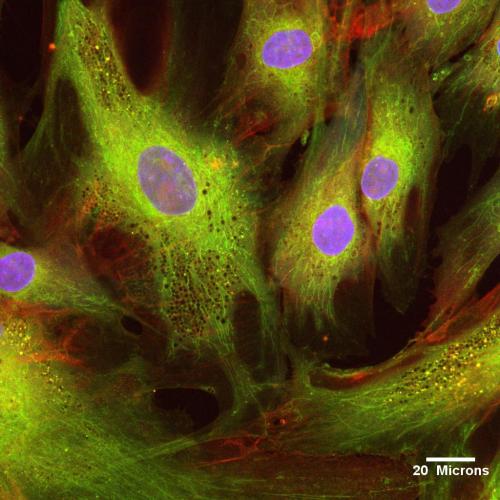Steering Stem Cells With Magnets

Steering Stem Cells with Magnets
Magnets could be a tool for directing stem cells’ healing powers to treat conditions such as heart disease or vascular disease.
By feeding stem cells tiny particles made of iron oxide, scientists at Emory and Georgia Tech can use magnets to attract the cells to a particular location in the body after intravenous injection.
The results are published online in the journal Small and will appear in an upcoming issue.
Human Adipose Derived Mesenchymal Stem Cells
More…
More Posts from Thejoyofscience and Others

What do you name a virus that is 1,000 times larger than the flu virus, has 200 times as many genes, and 93% of those genes are previously unknown to science? The mythical Pandora’s Box seemed an appropriate inspiration, and so the genus was dubbed Pandoravirus. These extra-large viruses may have been missed in the past because of their size, and were likely thought to be bacteria. Pandoraviruses do not behave typically, and may re-open the conversation regarding viruses as a life form. More info: http://bit.ly/1bwvYuY Image via Chantal Abergel and Jean-Michel Claverie


This is Phthirus pubis, a human louse, commonly known as “crabs" — it is known to infect pubic hair but can infect the EYELASHES.
I came across this while making a high yield vector borne disease lecture for an upcoming talk. On the clinical pathology boards, they apparently really like to show “gross" gross photographs of bugs and ask what is it or what disease does it cause. I have a fascination with tick born disease, so it felt natural to expand and learn some more entomology. My attending was looking through my lecture and said I needed to add an example of a louse and a flea, since people commonly mix them up. Well, I naturally started to google… and ended up grossing myself AND my attending out.
A job well done. Another excellent day on clinical microbiology.
PS - up until a year ago, I thought that “crabs" were actually miniature crabs. What? I wasn’t that far off! Both are apart of the phylum arthropoda!







Amazing Annual Monarch Butterfly Migrations
Monarch butterflies in other countries also migrate with the season, but it’s those in North America that travel the greatest distance. Each year, there are two major Monarch Butterfly migrations in North America. Those monarchs that live east of the Rocky Mountains fly down to Mexico, while the more western population stops in California. Monarchs do not like the cold, and as soon as things start to get a little chilly up north, they take off south (and west) for warmer climates.
The largest group travels over 1,250 miles from the Rocky Mountains to spend the winter in Michoacán, Mexico. The government of Mexico has managed to almost stamp out logging in the monarch’s wintering areas, a practice which once threatened the migrating insects. Working with environmental organizations and individuals, they have been encouraging communities to start eco-tourism enterprises by planting trees for the butterflies to nest. The monarch is a butterfly ruled by the sun. When the autumn sun reaches fifty two degrees above the horizon, the monarch reproduction cycle shuts down, and their great migration begins. When they begin their flight down to Mexico, they have never been there, yet every generation is able to find the exact same spot year after year where their previous ancestors spent the winter.
The second group travels from Ontario, Canado to spend their winters in Santa Cruz, California. You may wonder why the monarchs don’t simply stay and enjoy the warmer weather there year round. That’s because they need the milkweed plants on which their larvae feed, and those are more plentiful up north. So as soon as the weather starts to warm up, that’s where they return every year. Interestingly, not every generation of monarchs migrate. Some simply remain in their breeding ground. Those that do migrate are born at the end of summer or early autumn. Because of their trip to warmer climes, this special generation will outlive several younger generations that stay put. It will then be the migratory monarchs’ great grandchildren that follow the beat of their forebears’ wings.
in Ontario, Canada, in their summer home. It’s thought that the distinctive bright coloring of the monarchs acts as a warning to predators to stay away. Monarch butterflies are also poisonous and will make any animal that tries to eat them sick – hopefully sick enough not to try snacking on them a second time! The poison comes from the milkweed that they eat while they are caterpillars. This doesn’t always work, however. Certain bird species, for example, have learned that some parts of the butterflies are not as toxic, while other predators are resistant or immune to the poison altogether.
source

Usual interstitial pneumonia
It has the loose fibroblastic balls (pink balls) next to relatively normal lung parenchyma (thin septae) and a bronchiole (the blueish wrinkly thing)
(Via pulmonary pathology)
Medical lung is like… impossible. COP. DAD. DIP. NSIP. BOOP. POOP. SCHMOOP. No idea. It all looks the same to me.




“What’s that on the beach?!"
Monterey Bay beachcombers and divers were treated to a huge bloom of salps this weekend! Salps are gelatinous filter-feeders that drift with and feed in the plankton. Wind and waves sometimes blow these open-ocean emissaries onshore by the thousands, a feast for fishes, invertebrates—and for the eyes of curious naturalists!
There were several species of salps in this weekend’s bloom, including these in the genus Salpa. Salps do not sting—in fact, they’re more closely related to fishes and people than they are to other "jellies”! The brown/orange orb is the salp’s gut. Pumping muscle bands push water from one end of the animal to the other through an internal plankton-pasta strainer.
Salps have an incredibly successful reproductive strategy, allowing them to explode in numbers when conditions are right. Ready? Here we go: Salps can be found as solos, or as a chain of dozens of individuals attached together. Same species, two different body morphs. The solos produce the chain asexually, and the individuals in the chain are all clones.
OK, still with us? The next part is a doozy: A young chain is female, and each female clone produces another solo salp from an egg that is fertilized by older male chains. The older male chains are female chains that changed sex as they aged—this is called sequential hermaphroditism. This whole process allows salps to produce new generations at an incredible rate, to take advantage of fleeting oceanic conditions. Phew, we did it!
Salps are thought to have an outsized effect on the flow of nutrients in the ocean’s food web. Because their fecal pellets sink, salp poop delivers vital nutrition from the ocean surface to the deep seafloor, and helps take carbon from the atmosphere to the deep, which helps regulate the planet’s climate. Spent salps from these huge blooms become food for countless organisms throughout the water column. Certain deep sea communities may even depend on these ephemeral feasts to survive in the desert of the abyssal plain, according to research by our colleagues at the Monterey Bay Aquarium Research Institute (MBARI).
This weekend’s salp bloom is a jiggly reminder of the vast community of gelatinous drifters—the gelata—that drift in the open ocean, connecting the surface to the deep and adjusting the Earth’s energy flow, unseen by most until a chance encounter on the shore.
Photo: Charles Schrammel Gif: Alison Smith

Thunderstorm from space
This photo was taken from the International Space Station during a project to capture photos of clouds. Here a large anvil supercell (some 200 km across) is silhouetted against the limb of our blue orb, revealing clearly the layers of the atmosphere somewhere over northern Australia around 1,500 km from the station, which was then flying over Papua New Guinea.
Keep reading
-
 haemvz liked this · 9 years ago
haemvz liked this · 9 years ago -
 gostemcellresearch-blog reblogged this · 9 years ago
gostemcellresearch-blog reblogged this · 9 years ago -
 envisionedtomorrow reblogged this · 9 years ago
envisionedtomorrow reblogged this · 9 years ago -
 rollership liked this · 11 years ago
rollership liked this · 11 years ago -
 freethoughtsdroppedcalls reblogged this · 11 years ago
freethoughtsdroppedcalls reblogged this · 11 years ago -
 wawally reblogged this · 11 years ago
wawally reblogged this · 11 years ago -
 listen-look-feel reblogged this · 11 years ago
listen-look-feel reblogged this · 11 years ago -
 archeroflight reblogged this · 11 years ago
archeroflight reblogged this · 11 years ago -
 archeroflight liked this · 11 years ago
archeroflight liked this · 11 years ago -
 letitbeloveithard liked this · 11 years ago
letitbeloveithard liked this · 11 years ago -
 life--malignancy reblogged this · 11 years ago
life--malignancy reblogged this · 11 years ago -
 medisyntax-blog reblogged this · 11 years ago
medisyntax-blog reblogged this · 11 years ago -
 whocuddlesthecuttlefish liked this · 11 years ago
whocuddlesthecuttlefish liked this · 11 years ago -
 lawlcaptain reblogged this · 11 years ago
lawlcaptain reblogged this · 11 years ago -
 1ofthecurious reblogged this · 11 years ago
1ofthecurious reblogged this · 11 years ago -
 1ofthecurious liked this · 11 years ago
1ofthecurious liked this · 11 years ago -
 me-and-ennui reblogged this · 11 years ago
me-and-ennui reblogged this · 11 years ago -
 mirkintheskywithdiamonds-blog liked this · 11 years ago
mirkintheskywithdiamonds-blog liked this · 11 years ago -
 nawafalhamedi liked this · 11 years ago
nawafalhamedi liked this · 11 years ago -
 carbonatedwitch reblogged this · 11 years ago
carbonatedwitch reblogged this · 11 years ago -
 nandowo liked this · 11 years ago
nandowo liked this · 11 years ago -
 bungabungabulan reblogged this · 11 years ago
bungabungabulan reblogged this · 11 years ago -
 bungabungabulan liked this · 11 years ago
bungabungabulan liked this · 11 years ago -
 inappropriately-epic reblogged this · 11 years ago
inappropriately-epic reblogged this · 11 years ago -
 uwcdoverbiosoc reblogged this · 11 years ago
uwcdoverbiosoc reblogged this · 11 years ago -
 weareinspiredbyscience-blog liked this · 11 years ago
weareinspiredbyscience-blog liked this · 11 years ago
An assortment of scientific things from the wonderful world of biology
77 posts

